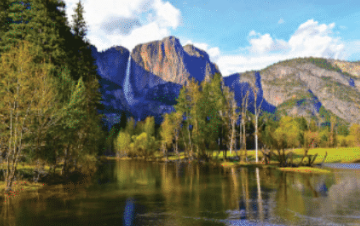Yosemite National Park
Yosemite National Park is a park in the USA and a UNESCO World Heritage site that is located in the Sierra Nevada mountains in east-central California. Approximately four million visitors each year come to Yosemite to see its spectacular granite cliffs, towering waterfalls, remote wilderness, massive sequoia trees, and high mountain meadows. People started to visit Yosemite 8,000 years ago. People have lived there for 4,000 years. President Abraham Lincoln signed a bill to protect the park in 1864. It was declared the third national park in 1890. Yosemite is best known for its impressive granite cliffs and domes. These formations were born approximately ten million years ago. The Tuolumne and Merced rivers are the two major river systems in the park. The park has some of the most impressive waterfalls in the world. If you only have a single day to visit the park, a drive around Yosemite Valley is probably the best option. Longer visits provide options for hiking and visiting sites outside the Valley. Visiting in winter provides the opportunity to see dramatic winter landscapes in Yosemite Valley or to ski in Badger Pass, but many roads are closed because of snow in winter. Spring is the best time to see the waterfalls at their strongest. During the summertime all park roads are open, and Tuolumne Meadows will be snow-free and full of flowers. Autumn offers a time with smaller crowds, cooler weather, and access to the entire park.

